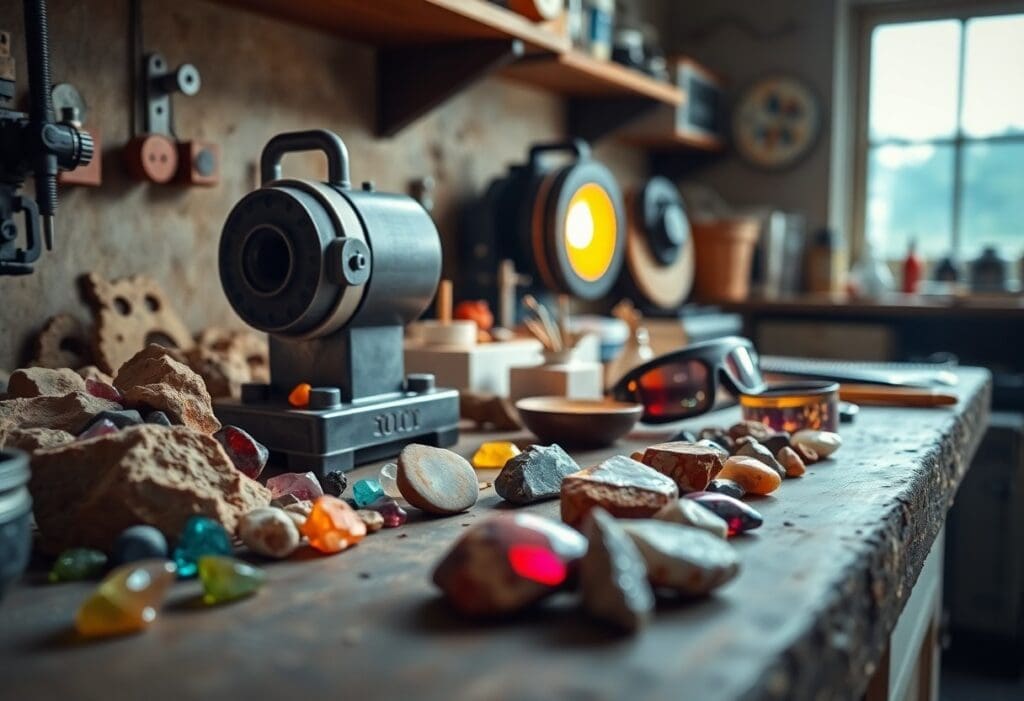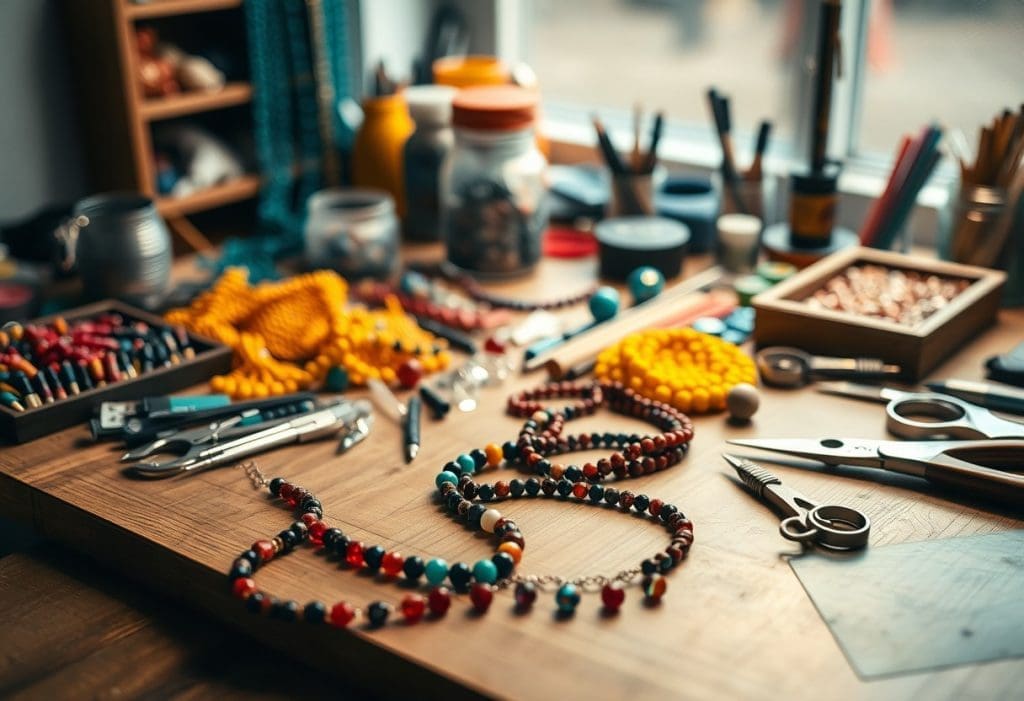Over the years, lapidary has become a fulfilling hobby for many enthusiasts eager to transform rough stones into polished gems.
In this guide, you will learn the fundamental steps needed to commence on your lapidary journey, including important tools, techniques for cutting and polishing stones, and safety measures to ensure a successful experience.
Whether you are an absolute beginner or looking to refine your skills, this post will equip you with the knowledge to create beautiful, custom stones that you can be proud of.
Breaking Down the Basics of Lapidary Arts
The Origins and Evolution of Lapidary
Lapidary, derived from the Latin word “lapidarius” meaning “stone worker,” dates back thousands of years.
Early civilizations, including the Egyptians and Mesopotamians, utilized stone cutting for jewelry and practical tools.
As the craft evolved through the ages, techniques advanced from simple hand tools to sophisticated machinery, enabling finer cuts and intricate designs.
Today, lapidary encompasses a diverse range of styles, methods, and materials, reflecting not only artistic expression but also technological innovation.
The Cultural Significance of Stone Cutting
Stone cutting holds deep cultural significance across various societies, often symbolizing status, spirituality, and human creativity.
From ancient burial artifacts to ceremonial pieces, gemstones and polished stones have represented connection to one’s heritage.
Indigenous cultures frequently use specific stones for talismans or healing, imbuing them with spiritual energies rooted in tradition.
On a broader scale, lapidary reflects the evolution of human artistry, showcasing how people across the globe have shaped and celebrated their environments through the ages.
Your connection to the cultural significance of stone cutting can extend beyond mere appreciation.
It embodies a lineage of craftsmanship that links you to generations past. In many cultures, gemstones serve both functional and ceremonial purposes, often believed to channel healing energy or enhance personal qualities.
For instance, jade is revered in Chinese culture for its protective properties, while turquoise has historically held spiritual meaning among Native American tribes.
Lapidary not only brings you closer to these rich traditions but also allows you to participate actively in a timeless practice that celebrates the beauty and meaning of the earth’s treasures.
Essential Tools and Equipment Every Beginner Needs
The Must-Have Tools for Stone Preparation
Starting with the basics, investing in a good set of tools for stone preparation is non-negotiable.
A diamond saw allows you to cut through tougher materials like quartz or agate, while grinding wheels help shape your stones into the desired form.
A set of files and sanders can smooth out jagged edges, ensuring a polished finish.
Safety gear—including goggles and a dust mask—will protect you from debris during your cutting and shaping processes.
Choosing the Right Polishing Systems
The polishing stage of lapidary work is where your stone truly shines, literally and figuratively.
The right polishing system can significantly impact the quality of your finished piece.
You have options ranging from rotary tools with varying grits to more advanced vibration or tumbling systems.
For a beginner, starting with a rotary tool and a kit of polishing pads will help you achieve great results without overwhelming complexity.
Polishing systems can differ widely in specifications and functionality.
Beginners often benefit from a rotary polisher, as it allows for immediate control and adaptability during the polishing process.
You might want to choose a system that offers interchangeable pads made from different materials—such as felt, foam, or leather—allowing you to experiment and find the perfect finish for each type of stone you work with.
Consider investing in a speed control feature to manage the polishing results based on the material’s hardness, ensuring that you don’t over-polish or damage your stones.
With the right tools, you’ll achieve that lustrous final look, making your creations dazzling and inviting.
Selecting the Right Stones for Your Projects
Gemstones vs. Minerals: Understanding Your Options
Understanding the difference between gemstones and minerals enhances your ability to choose the right stones for your projects.
Gemstones are typically rare and cut for ornamental purposes, like diamonds or sapphires.
On the other hand, minerals, which can be much more common, are often used for stone cutting and polishing due to their variety in color and structure, such as quartz or agate.
By knowing your options, you can better align your creative vision with the materials available.
Evaluating Quality: What to Look for in Raw Stones
Identifying quality in raw stones requires keen observation and a discerning eye. Look for consistent color, minimal cracks, and overall clarity.
High-quality stones often have fewer inclusions, which can affect their appearance and durability.
Additionally, consider the stone’s size and shape to ensure it fits your planned project design.
In addition to color and clarity, take the time to examine the stone’s texture and surface quality.
Stones with a smooth finish may indicate they have undergone prior handling, while rough stones can offer unique character.
Use a loupe or magnifying glass to inspect for stability and any potential fractures.
Stones that display a vibrant hue, minimal flaws, and solid structure will not only enhance your finished piece but also contribute to its long-term durability and beauty.
Each detail informs your choice, guiding you towards the most suitable gems or minerals for your lapidary endeavors.
Mastering the Techniques of Cutting and Shaping
Essential Cutting Techniques for Beginners
Starting your lapidary journey involves mastering vital cutting techniques that will form the foundation of your skill set.
Techniques such as the use of a diamond saw for precise cuts, the application of a grinding wheel for shaping, and the use of a lapidary trim saw can significantly impact your ability to transform rough stones into beautiful pieces.
Familiarize yourself with these methods to ease your entry into the more intricate aspects of stone finishing.
Advanced Shaping Methods: Going Beyond the Basics
Once you have a handle on basic cutting, delving into advanced shaping methods allows for more creativity.
Techniques like cabochon cutting, which enhances the stone’s natural beauty through a rounded, polished top, and faceting, which involves cutting multiple flat surfaces can elevate your craftsmanship.
Mastery of these methods not only broadens your capabilities but also enhances the overall aesthetic appeal of your creations.
- Cabochon Cutting
- Faceting
- Intarsia and Inlay Techniques
- Carving Techniques
| Method | Description |
|---|---|
| Cabochon Cutting | Cuts a stone into a smooth, rounded shape, perfect for pendants or rings. |
| Faceting | Creates flat surfaces on gems to reflect light, used in many gemstone rings. |
| Intarsia | Combines different materials into a single piece for intricate designs. |
| Carving | Involves shaping stones with tools to create artistic, three-dimensional forms. |
Exploring advanced shaping methods opens up a wealth of creative possibilities within lapidary arts.
Techniques like intarsia and carving allow you to personalize your designs, blending colors and textures, while enhancing the artistic expression in your work.
Each method brings its own set of tools and processes, enabling you to make unique pieces that reflect your vision.
The combination of different techniques can also lead to unexpected, innovative styles, pushing the boundaries of traditional lapidary practice.
- Experiment with various gemstones for different visual effects.
- Utilize different grinding and polishing techniques to enhance textures.
- Create your own designs using CAD software to visualize unique patterns.
- Seek feedback from fellow lapidarists to refine your skills.
| Technique | Application |
|---|---|
| CAD Software | Helps visualize designs before executing cuts. |
| Mixed Media | Combining stones with metals or other materials for unique jewelry. |
| Feedback Sessions | Using peer insights to advance your designs and craftsmanship. |
The Polishing Process: Bringing Your Stones to Life
Choosing the Right Polishing Materials and Compounds
Your choice of polishing materials and compounds can make a significant difference in the final appearance of your stones.
Common options include cerium oxide for quartz and jade, tin oxide for softer stones like opals, and diamond paste for harder minerals.
Always consider the hardness of your stone and select materials that complement its unique properties, ensuring a brilliant finish while minimizing the risk of damage.
Step-by-Step Guide to Achieving a Flawless Finish
Polishing your stones to perfection involves a systematic approach.
Start with coarser grits to eliminate scratches, gradually progressing to finer grits before finishing with a polishing compound.
Each step should be meticulously executed to ensure the surface reflects light beautifully.
Monitor the stone constantly to prevent overheating or chipping, which can undermine your hard work.
Step-by-Step Polishing Process
| 1. Begin with Coarse Grit | Use a coarse grit wheel to remove the bulk of imperfections. |
| 2. Progress to Medium Grit | Move on to a medium grit to refine surface scratches and prepare for finer polishing. |
| 3. Finalize with Fine Grit | Apply a fine grit to prepare the stone for the polishing compound. |
| 4. Use Polishing Compound | Finish your stone with the appropriate polishing compound for a high-gloss shine. |
| 5. Clean Thoroughly | Rinse your stone to remove any residue and enhance its beauty. |
This step-by-step guide becomes a practical roadmap as you engage with each stage.
With each pass, your stones begin to radiate a new brilliance, and the satisfaction of seeing your hard work transformed into beauty drives the enthusiasm for lapidary.
Take your time at each stage to ensure that every detail is honored—after all, the journey into stone polishing is as rewarding as the end result.
Safety First: Protecting Yourself While Lapidary
Personal Protective Equipment (PPE) You Can’t Ignore
Your lapidary adventure starts with crucial personal protective equipment (PPE) that safeguards you from potential hazards.
Always wear safety goggles to shield your eyes from flying debris and a dust mask to protect your lungs from fine particles.
Thick gloves provide a grip while also safeguarding your hands from cuts and scrapes, and an apron can help protect your clothing and body from sharp edges and contaminants.
Investing in quality PPE isn’t just smart; it’s vital for a safe working environment.
Safe Work Practices That Prevent Accidents
Implementing effective work practices is key to minimizing risks while you engage in lapidary.
Ensure your workspace is uncluttered and well-lit, providing a safe environment where tools and materials can be easily accessed without hazards.
Establish a clear workflow to avoid distractions, and always be mindful of machine operation guidelines to prevent accidents.
Always check that machines are properly maintained, and turn them off when not in use.
These practices enhance safety and help you focus on the creative aspects of your craft.
Moreover, take regular breaks to alleviate fatigue, which can lead to careless mistakes.
Develop a habit of double-checking your setup before starting to work, ensuring that everything is securely positioned.
Familiarize yourself with emergency procedures in case of a mishap.
Creating a culture of safety not only protects you but also enhances your overall lapidary experience, allowing you to concentrate fully on honing your skills and producing beautiful creations.
Creating Unique Designs: Adding Personal Flair
Integrating Personal Creativity into Your Lapidary Projects
Your stones offer endless possibilities for creativity and self-expression.
Experiment with varying shapes, colors, and sizes to create designs that reflect your unique aesthetic.
Drawing inspiration from nature, art history, or other artisans can lead to fresh ideas.
Consider incorporating personal symbols or themes that resonate with you, allowing each piece to tell its own story while showcasing your individuality.
Techniques for Setting Stones into Jewelry and Other Crafts
Setting stones effectively not only enhances their beauty but also elevates your lapidary projects into functional art.
Techniques such as wire wrapping, bezel setting, and prong setting are popular methods for securely embedding stones in jewelry.
Each technique offers a different aesthetic, so experimenting with various settings helps you discover which styles best suit your creations.
Wire wrapping allows for flexibility and creativity, making it an excellent choice for beginners.
This technique utilizes sturdy wire to create intricate designs around the stone, securing it while adding visual interest.
Bezel setting involves creating a metal frame to hold the stone in place, ideal for a polished, elegant look.
Prong setting, commonly seen in engagement rings, uses metal claws to elevate the stone for maximum brilliance.
Exploring these methods can help you find the perfect way to showcase your stones while enhancing their natural beauty.
Navigating the Lapidary Community and Market
Connecting with Other Lapidary Enthusiasts
Joining local and online lapidary groups fosters connections with fellow enthusiasts, allowing you to share tips, techniques, and inspiration.
Look for clubs or organizations in your area, or participate in online forums and social media groups that focus on lapidary work.
Regularly attending events like workshops, gem shows, or craft fairs can also expand your network and provide invaluable learning opportunities.
Engaging with others who share your passion creates a supportive environment for both beginners and seasoned lapidarists to improve their craft.
Understanding the Market: Selling Your Creations
Exploring the market for your lapidary creations offers a pathway to sustain your hobby or turn it into a viable business.
Identifying potential platforms—whether local craft fairs, online marketplaces, or social media—provides options for reaching different audiences.
Use good photography and effective storytelling about your work. These approaches can significantly impact your sales potential, as high-quality visuals help showcase the beauty of your stones.
Market trends vary widely based on region and customer preferences; thus, conducting thorough research is necessary to price your creations competitively.
Keep an eye on popular stone types, shapes, and finishes by following trends on platforms like Etsy or attending local gem shows.
Engaging with your audience through social media not only helps build brand loyalty but also provides direct feedback on what your customers are seeking.
By considering these factors, you can strategically position your work and pave the way for growth in your lapidary journey.
Summing up
Drawing together your journey into lapidary work involves understanding the crucial tools, techniques, and materials you’ll need to succeed in cutting and polishing stones.
Begin by familiarizing yourself with the right equipment, such as saws, grinders, and polishers, as well as choosing the right stones to work with.
As you practice and refine your skills, don’t hesitate to seek out community resources or tutorials to guide you.
With patience and creativity, you can transform rough stones into beautiful, polished gems. Your adventure in lapidary awaits!



